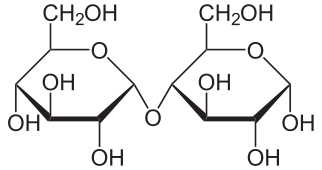Maltose: Difference between revisions
Jump to navigation
Jump to search
mNo edit summary |
No edit summary |
||
| (One intermediate revision by one other user not shown) | |||
| Line 1: | Line 1: | ||
Maltose is a [[Disaccharide|disaccharide]]. In maltose, two units of [[Glucose|glucose]] are joined in a [[Condensation Reaction|condensation reaction]] by an [[Glycosidic bond|alpha-1,4 glycosidic linkage]]. Maltose is produced by the [[Hydrolysis|hydrolysis]] of [[Starch|starch]] and can be hydrolysed to [[Glucose|glucose]] by the action of the [[Enzyme|enzyme]] [[Maltase|maltase]] | Maltose is a [[Disaccharide|disaccharide]]. In maltose, two units of [[Glucose|glucose]] are joined in a [[Condensation Reaction|condensation reaction]] by an [[Glycosidic bond|alpha-1,4 glycosidic linkage]]. Maltose is produced by the [[Hydrolysis|hydrolysis]] of [[Starch|starch]] and can be hydrolysed to [[Glucose|glucose]] by the action of the [[Enzyme|enzyme]] [[Maltase|maltase]]<ref>'Biochemistry', Fifth Edition, (2002), Jeremy M. Berg, John L. Tymoczko and Lubert Stryer, p.302</ref>. [[Image:Maltose.png|thumb|right]] | ||
=== References === | === References === | ||
<references /> | <references /> | ||
Latest revision as of 10:08, 8 December 2018
Maltose is a disaccharide. In maltose, two units of glucose are joined in a condensation reaction by an alpha-1,4 glycosidic linkage. Maltose is produced by the hydrolysis of starch and can be hydrolysed to glucose by the action of the enzyme maltase[1].

References
- ↑ 'Biochemistry', Fifth Edition, (2002), Jeremy M. Berg, John L. Tymoczko and Lubert Stryer, p.302